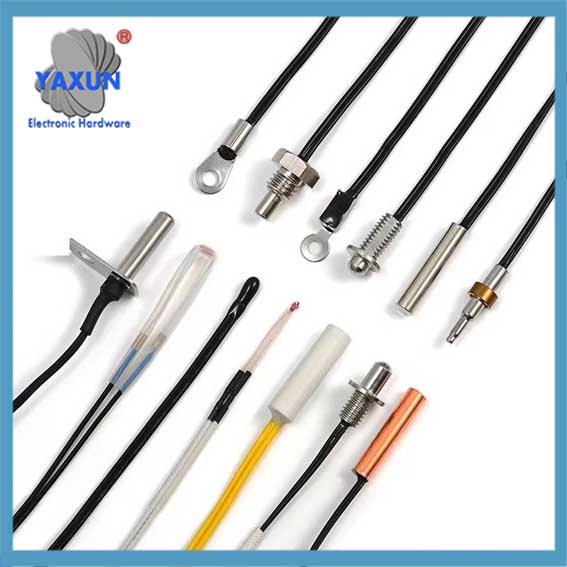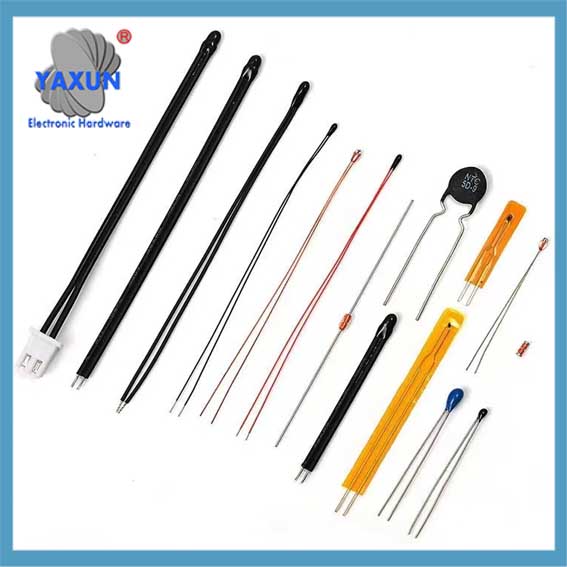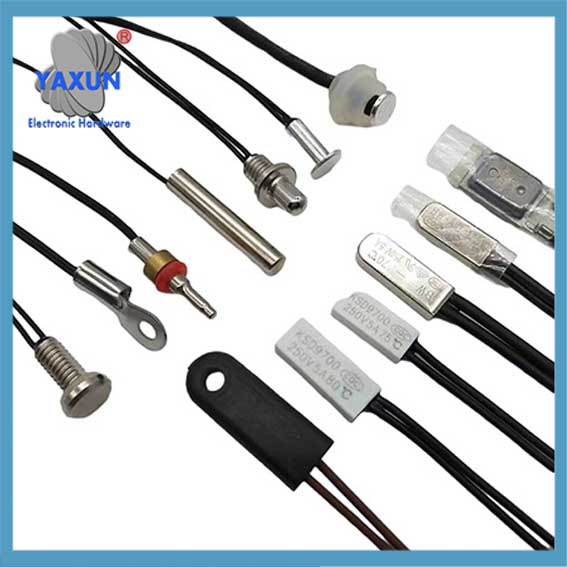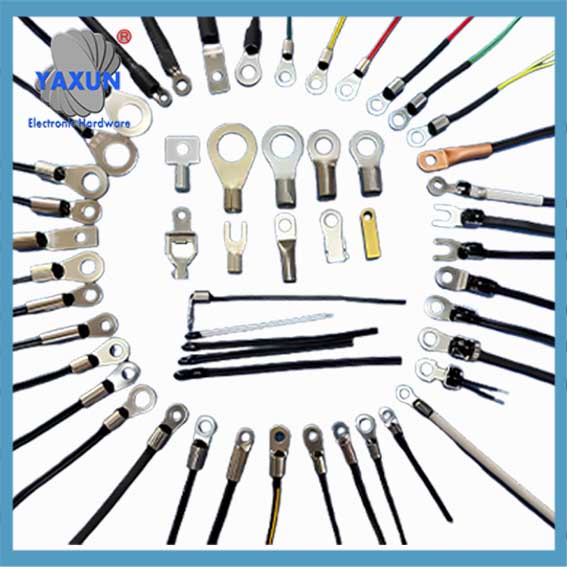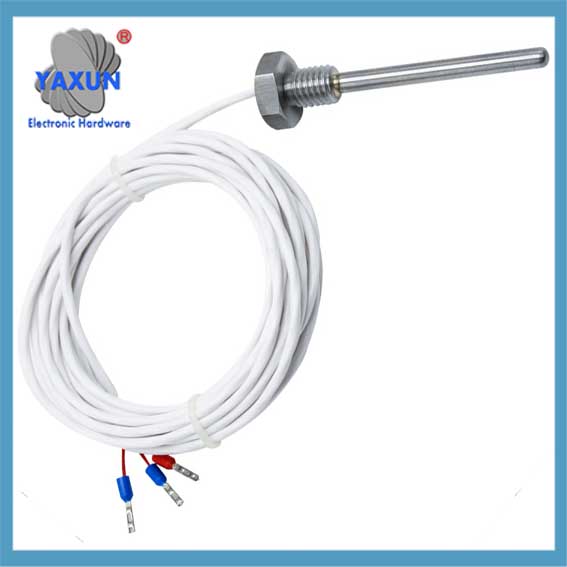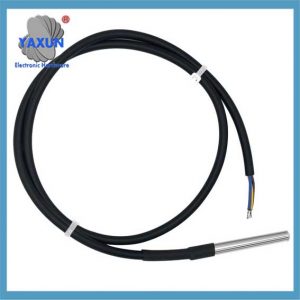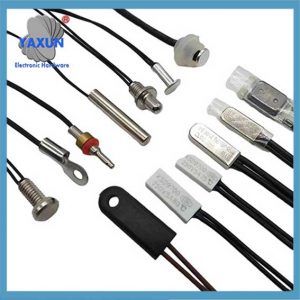Produkkategorieë
- Termiese lont 32
- Sekke van die oppervlakbevestiging 12
- termistor 36
- PCB Mount Fuse Holder 27
- Bedrading tuig 6
- Blade lonthouers 17
- termostaat 50
- Elektriese lont 24
- Motor temperatuur sensor 7
- Termiese stroombreker 22
- Sekeringskashouer 36
- Temperatuursensor 75
- Termiese skakelaar 68
- Motor lont 20
- Bout afsmeltings 8
Produk tags
Temperatuur sondes, Tipes temperatuursensors & toepassings
'n Temperatuursonde is 'n toestel wat gebruik word om temperatuur te meet, bestaan gewoonlik uit 'n sensitiewe element en 'n meetkring. Die sensitiewe element kan 'n termokoppel wees (pt100, pt1000), 'n termiese weerstand (ntc, ptc), 'n halfgeleier (DS18B20 digitaal), ens., wat temperatuurveranderinge in elektriese seine kan omskakel. Dan word dit versterk, gefiltreer, bekeer, en verwerk deur die meetkring, en laastens word 'n elektriese sein wat eweredig aan die temperatuur uitgestuur is.
Temperature probes and temperature sensors are two different devices, and they have their own characteristics and application scenarios in measuring temperature.
Temperature Probe
N “temperature probe” is a sensor used to measure temperature by converting the heat energy into a measurable electrical signal, and the most common types of temperature sensors within a probe include thermocouples, Resistance Temperature Detectors (RT's), and thermistors, each with distinct characteristics and applications based on the required accuracy, temperatuurreeks, and response time needed for a specific situation.
Definition: 'n Temperatuursonde is 'n toestel wat gebruik word om temperatuur te meet, bestaan gewoonlik uit 'n sensitiewe element en 'n meetkring. Die sensitiewe element kan 'n termokoppel wees (pt100, pt1000), 'n termiese weerstand (ntc, ptc), 'n halfgeleier (DS18B20 digitaal), ens., wat temperatuurveranderinge in elektriese seine kan omskakel. Dan word dit versterk, gefiltreer, bekeer, en verwerk deur die meetkring, en laastens word 'n elektriese sein wat eweredig aan die temperatuur uitgestuur is.
Working Principle: The working principle of the temperature probe is to use the response of the sensitive element to temperature changes to convert temperature changes into electrical signals. Common sensitive elements include thermocouples, termiese weerstande, halfgeleiers, ens. The working principle of the thermocouple is to use the thermoelectric effect of two different metals or alloys. When they are connected together and at different temperatures, an electromotive force proportional to the temperature is generated. The working principle of the thermal resistor is to use the property that the resistance of metal or semiconductor materials changes with temperature. When the temperature changes, the resistance value will also change accordingly. The working principle of semiconductor is to use the property that the conductivity of semiconductor material changes with temperature. When the temperature changes, the conductivity will also change accordingly.
Type: The types of temperature probes mainly include thermocouple probes, thermal resistor probes, semiconductor probes, ens. Thermocouple probes use thermocouples as sensitive elements, and have the characteristics of wide measurement range, vinnige reaksiespoed, and high precision. Thermal resistor probes use thermal resistors as sensitive elements, and have the characteristics of high measurement accuracy, goeie stabiliteit, and strong anti-interference ability. Semiconductor probes use semiconductors as sensitive elements, and have the characteristics of small size, ligte gewig, and low power consumption.
Application fields: Temperature probes are widely used in industry, scientific research, medical care, environmental protection and other fields. Such as temperature measurement and control in chemical, petroleum, metallurgie, elektrisiteit, pharmaceutical, food and other industries.
DS18B20 Temperature Sensor Cable with Probe
Wiring: Rooi(VCC), Yellow(Data), Swart(GND)
Wide temperature range of -55 ℃ ~ +125 ℃
Power supply: 3.0V ~ 5.5V
Tips: Using a 4.7K resistor between the Data and VCC will make the testing of the probe easilier.
Termokoppel:
Funksie: Generates a voltage difference based on the temperature at the junction of two dissimilar metal wires.
Pros: Wye temperatuurreeks (-200°C to 1750°C), relatively inexpensive, fast response time.
Cons: Lower accuracy compared to other sensors, requires calibration tables to convert voltage to temperature.
Aansoeke: High-temperature applications like furnaces, engine monitoring, industrial processes.
Termistor:
Applications of Temperature Probes:
Industrial Processes: Monitoring temperature in manufacturing processes like ovens, reactors, and extruders.
HVAC Systems: Regulating room temperature in buildings by monitoring air temperature.
Voedselveiligheid: Monitoring food temperature during cooking and storage to ensure food safety.
Mediese toestelle: Measuring body temperature in patients through probes inserted into the body.
Automotive Industry: Monitoring engine coolant temperature and cabin temperature.
Wetenskaplike Navorsing: Precise temperature measurements in experiments.
Temperatuursensor
Definition: A temperature sensor is a device that can convert temperature changes into electrical signals. It usually consists of a sensitive element and a signal processing circuit. Die sensitiewe element kan 'n termokoppel wees, thermal resistor, semiconductor, ens. The signal processing circuit can be an analog circuit, a digital circuit, ens., which together complete the acquisition, verwerking en uitset van temperatuurseine.
Working principle: The working principle of the temperature sensor is similar to that of the temperature probe. It also uses the response of the sensitive element to the temperature change to convert the temperature change into an electrical signal. Egter, the temperature sensor usually has a more complex signal processing circuit, which can perform more advanced processing on the temperature signal, such as digital conversion, data storage, communication, ens.
Type: The types of temperature sensors mainly include analog temperature sensors, digital temperature sensors, and intelligent temperature sensors. Analog temperature sensors output analog signals, which need to be converted into digital signals through analog-to-digital converters. Digital temperature sensors directly output digital signals, and have the characteristics of strong anti-interference ability, hoë akkuraatheid, and easy integration. Intelligent temperature sensors have functions such as self-diagnosis, self-kalibrasie, and communication, en kan afstandmonitering en beheer realiseer.
Features: The temperature sensor has the characteristics of high measurement accuracy, goeie stabiliteit, sterk anti-inmenging vermoë, and easy integration. Different types of temperature sensors have different characteristics, such as analog temperature sensors require analog-to-digital converters, digital temperature sensors directly output digital signals, and intelligent temperature sensors have functions such as self-diagnosis, self-kalibrasie, and communication.
Application fields: Temperature sensors are widely used in smart home, smart wearable, medical equipment, industrial automation, environmental monitoring and other fields, such as air conditioners, yskaste, wasmasjiene, thermometers, sphygmomanometers, industrial control systems, ens.
How to choose?
When choosing a temperature probe or temperature sensor, the following factors need to be considered:
Application environment: Oorweeg of die gemete omgewing spesiale toestande soos korrosiwiteit het, hoë temperatuur, hoë druk, ens., om geskikte materiale en beskermingsvlakke te kies.
Measurement range: Kies 'n geskikte sensor volgens die omvang van die temperatuur wat gemeet moet word om te verseker dat die sensor akkuraat binne die vereiste reeks kan meet.
Accuracy requirements: Select a sensor with corresponding accuracy according to the accuracy requirements of the application for temperature measurement.
Cost budget: Select a cost-effective sensor according to budget constraints.
How to use?
When using a temperature probe or temperature sensor, the following matters need to be noted:
Installasie: Install it correctly according to the installation instructions of the sensor to ensure that the sensor is in good contact with the object to be measured and avoid measurement errors caused by improper installation.
Bedrading: Koppel die seinlyn en kraglyn van die sensor korrek om die stabiliteit en akkuraatheid van seinoordrag te verseker.
Kalibrasie: Kalibreer die sensor gereeld om te verseker dat sy metingsakkuraatheid aan die toepassingsvereistes voldoen.
Instandhouding: Maak die sensor gereeld skoon en onderhou dit om stof te vermy, vuilheid, ens. affecting the measurement performance of the sensor.
Temperature probe sensor is one of the important products of our YXAUN company. We focus on the fields of intelligent manufacturing and industrial automation, and provide a series of high-precision and stable measurement and control equipment, including temperature probe sensors. Our temperature probe sensors are widely used in industrial manufacturing, omgewingsmonitering, energy management and other industries with their high precision, stability and adaptability to complex environments. If you have specific needs or questions about our temperature probe sensors, please feel free to consult us. We will wholeheartedly provide you with professional answers and services. What aspect of the temperature probe sensor do you want to know?
How to choose a suitable temperature probe sensor?
When choosing a temperature probe sensor, consider the temperature measurement range, akkuraatheidsvereistes, response speed and installation environment. Byvoorbeeld, thermocouples or platinum resistance can be selected for industrial environments, PT100 for high precision, and thermocouples for fast response.
Kontak ons
Wag vir u e -pos, Ons sal u binne antwoord 12 ure met waardevolle inligting wat u benodig.
 English
English Afrikaans
Afrikaans العربية
العربية বাংলা
বাংলা bosanski jezik
bosanski jezik Български
Български Català
Català 粤语
粤语 中文(简体)
中文(简体) 中文(漢字)
中文(漢字) Hrvatski
Hrvatski Čeština
Čeština Nederlands
Nederlands Eesti keel
Eesti keel Suomi
Suomi Français
Français Deutsch
Deutsch Ελληνικά
Ελληνικά हिन्दी; हिंदी
हिन्दी; हिंदी Magyar
Magyar Bahasa Indonesia
Bahasa Indonesia Italiano
Italiano 日本語
日本語 한국어
한국어 Latviešu valoda
Latviešu valoda Lietuvių kalba
Lietuvių kalba македонски јазик
македонски јазик Bahasa Melayu
Bahasa Melayu Norsk
Norsk پارسی
پارسی Polski
Polski Português
Português Română
Română Русский
Русский Cрпски језик
Cрпски језик Slovenčina
Slovenčina Slovenščina
Slovenščina Español
Español Svenska
Svenska ภาษาไทย
ภาษาไทย Türkçe
Türkçe Українська
Українська اردو
اردو Tiếng Việt
Tiếng Việt
